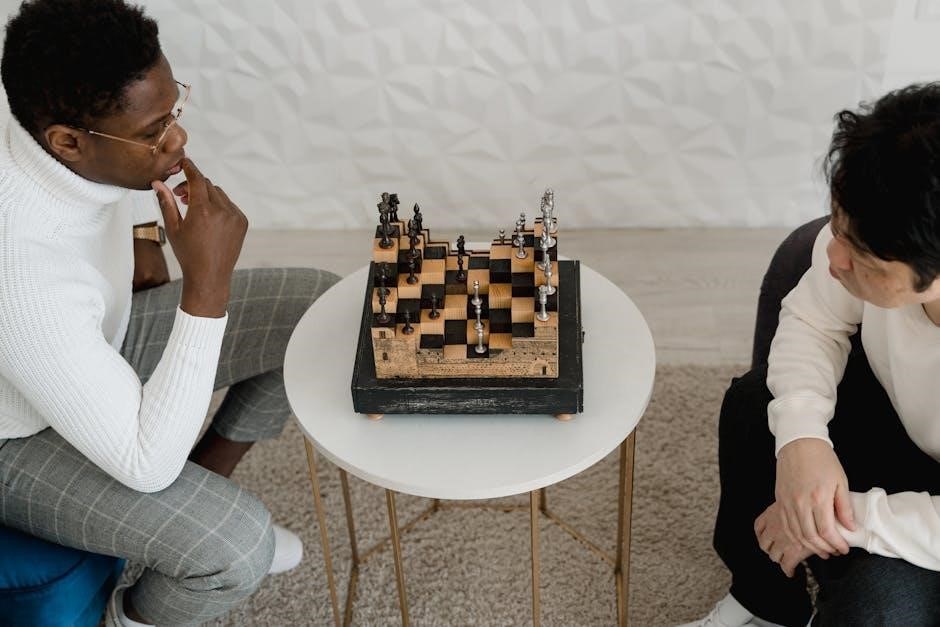Chess is a game of strategy and skill, requiring pattern recognition, critical thinking, and practice. Mastering it involves understanding openings, tactics, and endgame techniques. This guide provides essential principles and practical advice to improve your gameplay and increase your chances of winning. Study master games, analyze your moves, and refine your approach to become a formidable player.
1.1 Understanding the Basics of Chess Strategy
Chess strategy involves creating long-term plans to outmaneuver your opponent. It focuses on controlling key areas of the board, such as the center, and developing pieces effectively. Pattern recognition and tactical execution are crucial, as they enable you to anticipate threats and exploit weaknesses. A solid strategy requires understanding basic principles like pawn structure, piece placement, and king safety. By studying master games and practicing regularly, you can refine your strategic thinking and improve your overall gameplay. Remember, strategy is the foundation of success in chess, guiding your moves toward victory.
1.2 The Importance of Pattern Recognition in Chess
Pattern recognition is a cornerstone of chess success, enabling players to identify common tactical motifs and strategic ideas. By recognizing familiar patterns, such as forks, pins, and other tactical themes, players can anticipate threats and execute winning combinations. This skill allows for quicker decision-making and more accurate calculations. Studying master games and practicing puzzles enhances pattern recognition, helping players develop a deeper understanding of the game. It also improves their ability to adapt strategies to different positions. Over time, this skill becomes instinctive, leading to better outcomes and a stronger overall performance. Pattern recognition is essential for transforming knowledge into practical results on the board.

Chessboard Setup and Basic Rules
The chessboard consists of an 8×8 grid with alternating colors. Each player starts with 16 pieces: one king, one queen, two rooks, two knights, two bishops, and eight pawns. The objective is to protect your king while attempting to capture your opponent’s king. Pieces move according to specific rules, with pawns moving forward and other pieces having unique movement patterns. Understanding the setup and basic rules is fundamental for executing strategies and tactics effectively in any game.
2.1 Decoding the Chessboard Layout
The chessboard is an 8×8 grid with alternating light and dark squares. Each square is identified by a unique coordinate, combining a letter (a-h) for columns and a number (1-8) for rows. The first row (rank 1) holds the major pieces: rook, knight, bishop, queen, king, bishop, knight, and rook. The second row (rank 2) is filled with pawns. Understanding the board’s layout is essential for executing moves, as each piece’s movement is defined by its position and the squares it can control. The board’s structure also influences strategies, such as controlling the center or maneuvering pieces effectively during the game.
2.2 Chess Notation and Basic Lingo
Chess notation is a universal language that records games and communicates moves. Each square is identified by a letter (a-h) for columns and a number (1-8) for rows. Moves are written using piece symbols: R for rook, N for knight, B for bishop, Q for queen, K for king, and P for pawn (often omitted). For example, “e4” means moving the pawn to e4, while “Nf3” moves the knight to f3. Special terms like “x” for captures, “#” for checkmate, and “0-0” for castling are essential. Understanding this lingo is crucial for studying games, analyzing strategies, and improving your skills. It bridges communication among players worldwide.

The Fundamentals of Chess Openings
Mastering the basics of chess openings is crucial for setting up a strong position. Focus on controlling the center, rapid piece development, and maintaining a safe king position to build a solid foundation for the rest of the game.
3.1 Key Opening Principles for Beginners
Beginners should focus on controlling the center with pawns and pieces, ensuring rapid development, and maintaining king safety. Avoid weak pawn moves that don’t contribute to control or development. Prioritize moving pieces out harmoniously and creating space for your pieces to maneuver. Understanding these strategic ideas is more important than memorizing specific lines. By following these principles, you’ll build a solid foundation and transition smoothly into the middle game with a competitive position. These guidelines help avoid common pitfalls and set the stage for long-term success in your games.
3.2 The Role of Pawn Structure in the Opening
Pawn structure is crucial in the opening, as it determines space control and mobility. Beginners should avoid unnecessary pawn moves that weaken their position or create long-term liabilities. Pawns should be placed to support piece development and control key central squares. Open lines and pawn chains can influence the game’s flow, so understanding how to build and maintain a flexible structure is vital. A well-structured pawn center enhances piece activity and limits the opponent’s options. Conversely, poor pawn moves can lead to weaknesses that are exploited later. Managing pawns effectively in the opening sets the foundation for a successful game and avoids strategic disadvantages.

The Middle Game Strategies
The middle game focuses on tactical execution and positional play. It requires balancing short-term threats with long-term plans, transitioning smoothly from the opening to the endgame.
4.1 Tactical Patterns and Combinations
Tactical patterns and combinations are the building blocks of successful middle game play. They involve recognizing common motifs like forks, pins, and skewers to gain a decisive advantage. Players must master these patterns to outmaneuver opponents. Coevolutionary techniques and schematic thinking enhance the ability to spot and execute tactical ideas. Regular practice and study of master games help refine this skill. By focusing on tactical execution, players can turn positional advantages into winning opportunities. Understanding these patterns is crucial for improving your game and achieving victory.
4.2 The Art of Trading Pieces Effectively
Trading pieces effectively is a cornerstone of chess strategy, requiring careful assessment of value and position. Each exchange should aim to achieve a tangible advantage, such as gaining material, improving your position, or weakening your opponent’s structure. Understanding the relative value of pieces is crucial, as is recognizing when to accept or decline a trade. Tactical motifs like forks and pins often dictate the timing of exchanges. Always consider the long-term consequences of a trade, as it can shape the remainder of the game. Mastering this art enhances your ability to control the board and outmaneuver your opponent.

Position Evaluation and Planning
Position evaluation involves assessing strengths, weaknesses, and imbalances. Planning requires setting strategic goals and executing tactical ideas to achieve them. Accurate analysis is key to success.
5.1 How to Analyze Positions Accurately
Accurate position analysis is crucial for making informed decisions. Start by evaluating material balance, piece activity, and pawn structure. Identify weaknesses and strengths on both sides. Consider tactical motifs like forks, pins, and skewers. Assess king safety and control of key squares. Use chess engines or diagrams to visualize possibilities. Practice regularly to sharpen your analytical skills. This systematic approach helps you uncover hidden threats and opportunities, enabling better strategic planning and execution during the game.
5.2 Developing a Winning Plan
Creating a winning plan involves setting clear, achievable goals based on the position. Identify your advantages and target your opponent’s weaknesses. Consider long-term strategies, such as controlling key squares or creating pawn breaks. Adapt your plan as the game evolves, staying flexible to exploit new opportunities. Prioritize material balance, piece activity, and king safety. Use tactical motifs like forks or pins to gain an edge. Break down complex positions into manageable parts and calculate variations carefully. A well-structured plan guides your moves, helping you navigate the game effectively and convert advantages into victories. Consistent practice sharpens your ability to formulate and execute winning strategies.

The Endgame Techniques
Mastering the endgame involves converting advantages into wins. Focus on king activity, pawn promotion, and exploiting material imbalances. Key techniques include checkmates, simplifying positions, and precise calculation to secure victories.
6.1 Essential Endgame Principles
The endgame is a critical phase where precision and strategy determine the outcome. Key principles include activating the king, optimizing pawn structure, and creating threats to force concessions. Focus on promoting pawns, exploiting material advantages, and delivering checkmate. Understanding basic checkmates, such as king and rook versus king, is vital. Timing and coordination are essential to convert advantages into wins. Avoid unnecessary complications and aim for simplicity. Practice endgame scenarios to refine your technique and improve decision-making under pressure. Mastery of these principles ensures consistent success in the final stages of the game.
6.2 Converting Advantages into Wins
Converting advantages into wins requires precise strategy and execution. Focus on creating threats, activating your king, and promoting pawns. Avoid unnecessary risks and simplify positions to maximize your edge. Timing is crucial—strike when your opponent is vulnerable. Maintain initiative to prevent counterplay and force concessions. Pawn structure and piece activity are key levers. Deliver checkmate or achieve a material imbalance that guarantees victory. Practice endgame scenarios to refine your technique and build confidence. Mastering these skills ensures you turn advantages into wins consistently, elevating your gameplay to the next level.

Advanced Tactical Motifs
Advanced tactical motifs involve sophisticated patterns like forks, pins, and skewers, requiring deep strategic insight. These complex techniques, rooted in the Soviet school of chess, enable players to outmaneuver opponents effectively.
7.1 Forks, Pins, and Other Tactical Motifs
Forks, pins, and skewers are powerful tactical motifs that can turn the tide of a game. A fork attacks multiple pieces simultaneously, forcing the opponent into a difficult choice. Pins exploit protected pieces, creating threats against more valuable targets behind. Skewers, the reverse of pins, attack a valuable piece to expose a less valuable one. These motifs often lead to material gains or positional advantages. Mastering them requires recognizing patterns and calculating variations accurately. By incorporating these tactics into your play, you can outmaneuver opponents and execute decisive combinations. Regular practice and study of master games will enhance your ability to spot and execute these motifs effectively.
7.2 Schematic Thinking in the Middle Game
Schematic thinking in the middle game involves recognizing patterns and structures that guide strategic decisions. It requires players to identify recurring themes, such as pawn structures, piece placements, and tactical motifs, and apply them to current positions. By categorizing situations into familiar schemas, players can simplify complex scenarios and make more effective decisions. This approach emphasizes long-term planning over short-term gains, enabling players to build lasting advantages. Studying master games and practicing pattern recognition are essential for developing this skill. Schematic thinking transforms chaos into clarity, helping players navigate the middle game with confidence and precision, leading to more consistent and successful outcomes.

Psychological Aspects of Chess
Chess demands mental resilience, focus, and emotional control. Players must manage pressure, anticipate opponents’ moves, and maintain composure under stress. These psychological traits are as crucial as technical skill in achieving victory and sustaining performance over time.
8.1 Managing Pressure During the Game
Managing pressure during a chess game is crucial for maintaining clarity and decision-making. Players often face stress due to time constraints or complex positions. Techniques like deep breathing and positive self-talk can help stay calm. Emotional stability allows focus on strategic objectives rather than the fear of losing. Experienced players emphasize the importance of mental resilience, as it directly impacts performance. By training the mind to remain composed under pressure, players can execute plans more effectively and avoid blunders. This mental discipline is a key factor in achieving consistent results and outperforming opponents in high-stakes situations.
8.2 Maintaining Focus and Concentration
Maintaining focus and concentration is vital for success in chess. Players must stay mentally sharp throughout the game, avoiding distractions and fatigue. Techniques like visualization, mindfulness, and regular mental breaks can enhance focus. Training the mind to stay present ensures better decision-making and strategic execution. Experienced players often use pre-game routines to prepare mentally, while others rely on note-taking to track their thoughts. Consistent practice and mental exercises, such as puzzles or study sessions, also improve concentration. By cultivating these habits, players can sustain their attention and perform at their best, even in lengthy or high-pressure games.

Famous Chess Games and Lessons Learned
Studying famous chess games reveals timeless strategies and tactics. Analyzing masterpieces by legends offers insights into winning techniques, helping players refine their skills and decision-making abilities.
9.1 Analyzing Games of Chess Legends
Studying games of chess legends provides invaluable insights into winning strategies. By examining masterpieces from players like Bobby Fischer, Garry Kasparov, and Magnus Carlsen, you can learn how they outmaneuvered opponents. These games reveal key principles such as tactical execution, positional play, and endgame mastery. Analyzing their decisions helps you understand how to exploit weaknesses and capitalize on advantages. Observing their patterns and techniques can refine your own gameplay, enabling you to adopt similar approaches in your matches. This method of learning accelerates improvement and equips you with a deeper understanding of chess fundamentals and advanced concepts.
9.2 Strategic Insights from Master Games
Master games offer timeless lessons in strategy, revealing how legends like Bobby Fischer and Garry Kasparov outclassed opponents. These games highlight the importance of long-term planning, adaptability, and exploiting positional advantages. By studying their approaches, you can learn to prioritize pawn structures, piece placement, and tactical execution. Insights include the value of controlling key squares, manipulating space, and preparing for transitions between game phases. These strategies demonstrate how to build winning positions and convert advantages into victories. Incorporating these principles into your play enhances your ability to navigate complex scenarios and make decisive moves, elevating your chess performance to new heights.
Consistent practice, study of master games, and focusing on openings, tactics, and endgames are key to success. Analyze your games, stay adaptable, and continuously refine your strategy to excel in chess.
10.1 Summarizing Key Strategies
Mastering chess requires a balanced approach, blending strategy and tactics. Control the center, develop pieces harmoniously, and maintain a strong pawn structure. In the opening, focus on quick development and safety. During the middle game, identify tactical patterns like forks and pins, and trade pieces effectively. Plan strategically, considering long-term goals. In the endgame, simplify positions and convert advantages into wins. Stay adaptable, analyze positions accurately, and maintain psychological resilience. Continuous learning through master games and resources is essential for improvement. By integrating these principles, you’ll enhance your gameplay and increase your chances of success.
10.2 Continuous Improvement in Chess
Improving at chess requires consistent effort and a well-rounded approach. Regularly study master games, focusing on strategic insights and tactical patterns. Utilize resources like chess books, PDF guides, and online tools to deepen your understanding. Practice tactics daily to sharpen your calculation skills. Analyze your own games to identify weaknesses and areas for growth. Engage in regular play to apply new concepts and refine your decision-making. Stay updated with modern strategies and adapt your style to different situations. Join chess communities or work with a coach for personalized feedback. Continuous learning and dedication are key to achieving long-term success in chess.

Additional Resources for Further Study
Explore chess books like “The Complete Book of Chess Strategy” and online tools for interactive learning. Visit websites like exeterchessclub.org.uk for free PDF guides and tutorials to enhance your skills.
11.1 Recommended Chess Books and PDFs
For in-depth learning, consider “The Complete Book of Chess Strategy” by Jeremy Silman, offering grandmaster techniques from A-Z. “Chess Strategy” by Edward Lasker is another classic, focusing on fundamental principles. Download free PDFs from websites like exeterchessclub.org.uk, which provide comprehensive guides and tutorials. Additionally, interactive tools like AI-powered eBook readers can enhance your study of chess books. These resources cover openings, tactics, and endgame techniques, ensuring a well-rounded improvement in your gameplay. Utilize these materials to deepen your understanding and refine your skills effectively.
11.2 Online Tools and Tutorials
Enhance your chess learning with online tools and tutorials. Websites like Chess.com and Lichess.org offer interactive lessons, puzzles, and videos. YouTube channels provide step-by-step guides, such as the “Learn Chess Step by Step” playlist. AI-powered eBook readers allow you to explore chess diagrams interactively. Platforms like Chess24 host live broadcasts and grandmaster commentary. Additionally, downloadable PDFs and PGNs from sites like exeterchessclub.org.uk offer structured courses. These resources cater to all skill levels, helping you master tactics, strategies, and game analysis. Utilize these tools to refine your skills and stay updated with the latest trends in chess.

Leave a Reply
You must be logged in to post a comment.